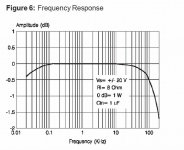Dear All, I would like to build a 2-ways TDA 7264 btl as amp for sub, can anybody give me a circuit sketch cos i don't know how to design.
The tda7264 will be taken off my old home theatre system, and the datasheet you can view via http://www.datasheetcatalog.org/datasheet/SGSThomsonMicroelectronics/mXytyq.pdf
any kinda help will be very appreciated.
The tda7264 will be taken off my old home theatre system, and the datasheet you can view via http://www.datasheetcatalog.org/datasheet/SGSThomsonMicroelectronics/mXytyq.pdf
any kinda help will be very appreciated.
By looking at the figure of the frequency response of the chip ,the output drops exactly from 100 Hz , so it's not a good choice for powering a sub
I see the output drop as you say, could you please recommend an IC or driver IC for powering a sub?
thanks in advance.
By looking at the figure of the frequency response of the chip ,the output drops exactly from 100 Hz , so it's not a good choice for powering a sub
According to the chart the output drops less than .5db (.3db) from 100hz to 20hz.
This chip won't have any problems for sub use except that it only has an output power of 20 watts which is very limiting for subwoofer use.
jer
Attachments
Read the print - it says with Cin = 1uF. If you want a lower cut off frequencey, use a larger input cap. And, as previously mentioned, it is only down .5 db at 20Hz, so is not a big deal to begin with. Since the feedback is internal, would require an external circuit (phase inverter) to run bridged. Also, want to keep supply to 16V for bridged operation - think 4 ohm equivalent load for each channel when bridged into 8 ohms.
According to the chart the output drops less than .5db (.3db) from 100hz to 20hz.
This chip won't have any problems for sub use except that it only has an output power of 20 watts which is very limiting for subwoofer use.
jer
what about to use it as a driver to drive a couples of diod or mosfets?
will it work that way to compensate it's limit in output power?
That is a whole another topology It has been mentioned before and has been done with such chips as the LM1877.
It might be something fun to research,But if you need more power you are better off just getting a higher power chip and starting there, like the LM3886 or TDA7293 or TDA7294 or somthing.
jer
It might be something fun to research,But if you need more power you are better off just getting a higher power chip and starting there, like the LM3886 or TDA7293 or TDA7294 or somthing.
jer
That is a whole another topology It has been mentioned before and has been done with such chips as the LM1877.
It might be something fun to research,But if you need more power you are better off just getting a higher power chip and starting there, like the LM3886 or TDA7293 or TDA7294 or somthing.
jer
Jer:
Thanks Jer.
by the way, what's the difference between class D and class AB power sub amp?
because it seems good to use a class D power sub amp.
It is the circuit topology ,based on how output devices work ( consequently ,on how they're driven) .
You just need the amplifier which would provide enough current to pump the driver .
Given that subwoofers work in a very narrow band , you can MAXIMIZE the power requirement ,trading bandwidth for efficiency .

You just need the amplifier which would provide enough current to pump the driver .
Given that subwoofers work in a very narrow band , you can MAXIMIZE the power requirement ,trading bandwidth for efficiency .
I personally am not into Class D design although I do like the technology very much.
Class D uses Pulse Width Modulation to create an ampilfied analog signal for the speaker to opreate on.
This is very diferent From class A or AB designs wich are strictly linear in their operation.
Their are many Class D configurations to choose from ranging from IC's to discrete configurations and are typicaly over 90% effecient.
And from what I understand you can build quite a Hefty amp for pretty cheap that has very good specs.
There is a whole forum section here just for Class D operation and alot of very knowledgable people that could give you a better answer than I as to what is available and what works good.
I am mostly an analog buff but one day I will venture down the road of Class D myself.
Cheers! jer
Class D uses Pulse Width Modulation to create an ampilfied analog signal for the speaker to opreate on.
This is very diferent From class A or AB designs wich are strictly linear in their operation.
Their are many Class D configurations to choose from ranging from IC's to discrete configurations and are typicaly over 90% effecient.
And from what I understand you can build quite a Hefty amp for pretty cheap that has very good specs.
There is a whole forum section here just for Class D operation and alot of very knowledgable people that could give you a better answer than I as to what is available and what works good.
I am mostly an analog buff but one day I will venture down the road of Class D myself.
Cheers! jer
- Status
- This old topic is closed. If you want to reopen this topic, contact a moderator using the "Report Post" button.
- Home
- Amplifiers
- Chip Amps
- need for tda 7264 BTL circuit
